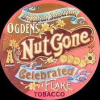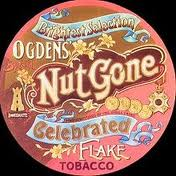Arguably, 1968 was a fantastic year for music. With artists such as Aretha Franklin and her album Lady Soul, Moody Blues and their opus of In Search of the Lost Chord, Pink Floyd’s A Saucerful of Secrets and Louis Armstrong’s What A Wonderful World all making a deep impact onto the record buying publics purse strings that year, surely the stand out album was Britain’s premier Psychedelic Rock band, The Small Faces and their album Ogdens’ Nut Gone Flake.
Ogdens’ Nut Gone Flake was on its release, fated to go to the top spot of the British charts. There had been other concept albums before and there would be many more after wards but the Small Faces touched upon something that only The Beatles had come close to achieving in 1967 with Sgt. Pepper’s Lonely Hearts Club Band. Up against such strong opposition and in an era when incredible music was the norm, The Small Faces may have been astounded to hold on to the number one spot for an amazing six weeks.
The four members of the band, Steve Marriott, Ronnie Lane, Kenney Jones and Ian Mclagan would never create this album live, the complexity of the music all but negating the possibility (this was finally rectified in the last decade but without the much missed Steve Marriott and Ronnie Lane.)
The album itself plays on the idea of unique fairy-tales; psychedelic philosophy and an almost early look of performance art. By having well known comic actor and creator of his own language, Unwinese, Stanley Unwin on the record, it was the perfect addition to the bands ‘B’ Side and the story of Happiness Stan.
The album cover itself creates the allusion to comic genius that would parade itself through the record and go hand in hand with the serious nature of some of the songs and the biting lyrics contained within. On the front of the album is a wonderful parody to a famous Liverpool brand of rolling tobacco. This may not have been seen by the greater music buying public at the time, especially those from down south but it added warmth and distinction that played heavily against some of the albums at the time which had the artists face on the album but not a distinctive selling point. In a world where advertising was blurring with art, this was a clever and unique marketing tool.
The A- side depended heavily on a very early heavy rock sound and included the false cockney knees up tunes of Lazy Sunday and Rene. Lazy Sunday was inspired by Steve Marriott’s feuds with his neighbours and is possibly one of the band’s best known songs. Its jaunty feel is the perfect antidote to the meaning bubbling beneath the surface of the song where at one point you hear the neighbour bang on the walls and tell the singer to “shut that noise down”. This antipathy is mirrored in the song Rene in which the listener can imagine some back street dock town pub and its regular drinkers crowding round a piano to tell the story of the local prostitute, Rene, and an early warning to the sailors and stevedores that visit town that, you might find a little comfort after months at sea but there are many secrets she keeps hidden, especially the amount of numerous children of all size and colour.
From the beautifully haunting Afterglow (Of Your Love) through to the final track of Happy Days Toy Town, the album has the feel of a classic stamped all over it. Not just one of the finest albums of that particular year but also of the last 50 years.
Allmusic refers to the Small Faces as “the best English band never to make it big in America”, In the end I have to agree, it would be foolish not to, however in the end that doesn’t matter, they remain deeply loved in the U.K. even to this day and with the re-release of Ogdens’ Nut Gone Flake it will surely see the Small Faces remain one of the finest bands to grace the British charts ever.
Ian D. Hall

